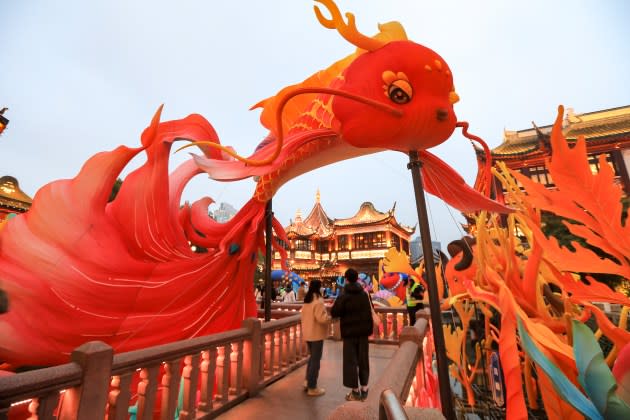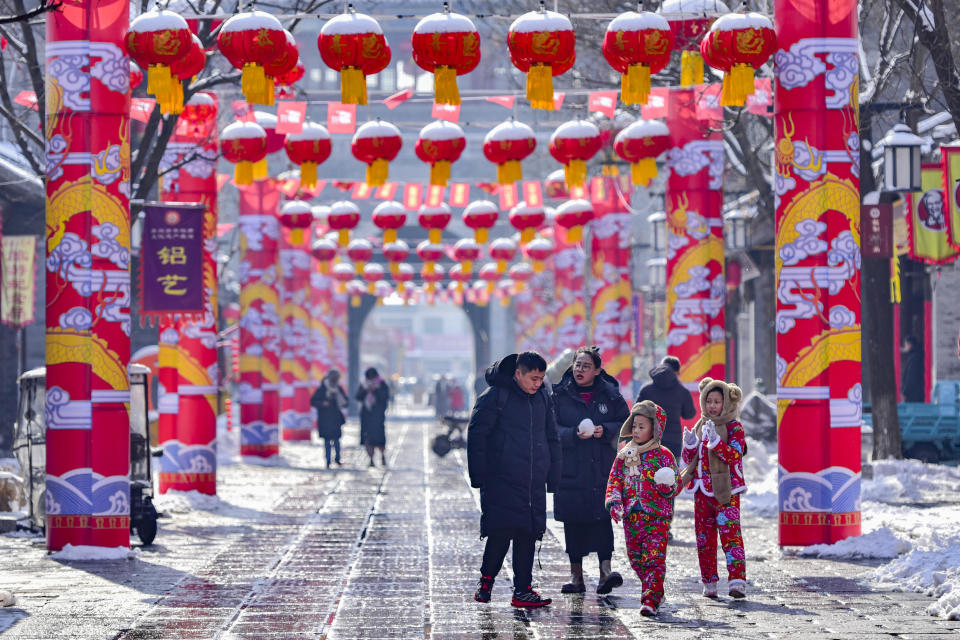Stocks Plunge, Job Worries Cast Shadow on Lunar New Year Spending in China

China’s Lunar New Year, which will welcome the Year of the Dragon on Saturday, is expected to log 9 billion domestic trips this year, almost doubling the number taken during last year’s holiday rush.
Widely considered the world’s largest human migration, this year’s official seven-day holiday begins on the day of the new year, but for a large number of people, the holiday can last for up to a month.
More from WWD
EXCLUSIVE: Loewe Is Mounting a Craft-focused Exhibition in China
Media People: Alex Sun on How to Run Legacy Media in Today's China
According to data from the travel booking platform Trip.com, bookings for outbound travel were 10 times the amount of last year, with Asian destinations — including Thailand, Japan and South Korea — the most popular. The National Immigration Administration recently told state media that outbound travel passenger traffic has returned to the pre-COVID-19 levels of 2019.
However, an uncertain macroeconomic climate in China has made investors wonder if a long-awaited rebound could unfold in the new year.
For the past few weeks, a floundering stock market — the CSI 300 Index, a capitalization-weighted stock market index designed to reflect the performance of the top 300 stocks traded on the Shanghai Stock Exchange and the Shenzhen Stock Exchange, fell 5.49 percent year-to-date — has dampened hope across the board, including a pool of small Chinese investors, who make up around 25 percent of the market.
Shortly after the slump, China’s Ministry of Finance pledged to maintain fiscal expansion at a “necessary intensity” to enhance “the positive trend of economic recovery.”
At the same time, China’s employment prospects are worsening as previous crackdowns on the tech and property sectors are trickling down to smaller firms. China’s manufacturing activity contracted for the fourth straight month in January, while the nation’s services activity expanded at a slightly slower pace in the period.
Grappling with rising costs, consequences of geopolitical tensions, and a shrinking population, average monthly salaries in 38 major Chinese cities dropped by 1.3 percent in the fourth quarter of 2023, the biggest quarterly decline since 2016, according to Zhilian Zhaopin, a job recruitment platform. The jobless rate in December for the 16-to-24 age group stood at 14.9 percent, excluding students, according to the National Bureau of Statistics.

Despite gloomy headlines, Goldman Sachs maintained a “constructive” view of China’s economy.
“We forecast 18 percent and 19 percent potential returns for MSCI China and CSI300 in 2024, predicated on around 5 percent real GDP growth and assuming an effective policy put [into place], approximately 10 percent EPS growth realization, and moderate valuation recovery,” said the report, published on Jan. 23.
Goldman Sachs also said that “a comprehensive and forceful easing package,” “demand-side-focused stimulus,” and “confidence-boosting policy targeting the private economy,” “government backstop in the housing and stock markets,” and “improvement and predictability in U.S.-China relations” are key catalysts to turn the current situation around.
During the Beijing “Two Sessions” meeting in March, China will unveil its 2024 GDP target. According to IMF forecasts, the economy will slow to growth of 4.6 percent in 2024 from 2023’s 5.4 percent.
Bank of America Securities anticipated that Lunar New Year sales would increase around 4 percent to 6 percent year-over-year.
In terms of consumer segmentation, Bernstein believes that the country’s “Premium Consuming Class,” or the top 93 million earners, are expected to drive 5.4 percent sustained growth for the next three years, especially for high-end categories such as luxury leather goods, ultra-premium Baijiu, or Chinese white wine, international prestige cosmetics, and premium automobiles.
“We expect the cohort population to grow at a 5.4 percent compounded annual growth rate from 2022 to 2027, adding an incremental 28 million members by 2027,” Bernstein added.
“This exceeds the growth of the equivalent consumer cohort in India, Indonesia, and Vietnam combined,” wrote Bernstein.
Bernstein also noted that a cluster of cities around the Yangtze River Delta and the Guangdong Bay Area, Fujian and Sichuan provinces, will play a dominant role in driving premium goods growth.
Bernstein favors premium brands that are investing in Shandong, Fujian, and Sichuan, which are “the most underappreciated Premium Consuming Class growth opportunities in China.”
“We like brand owners showing a clear geographic focus,” added the report.

Top-tier players have been busy pushing Lunar New Year-themed collections with a slew of experiential activations across key luxury retail destinations to sustain growth in a bearish market. Fendi, for example, put its largest pop-up activation for its Fendi x Frgmt x Pokémon three-way collaboration in Taikoo Li Chengdu, where Louis Vuitton and Gucci also put out dragon-themed installations to attract business.
In Taikoo Li’s Guangzhou counterpart Taikoo Hui, working together with Penique Productions, the Spanish company that covered the Louis Vuitton spring 2024 show venue in orange, the Taiwan-based immersive experience creator Inception filled the giant glass ceiling at the top of the mall with a larger-than-life red balloon, where shoppers can go inside and explore the submerged dragon installation.
In Shanghai, the Fosun-owned shopping destination Yu Garden put on a dazzling lantern show with oversized mythical dragons and sea creatures jumping on the zig-zag bridge, where Lanvin hosted its spring 2021 show. According to local reports, it helped nearby restaurants achieve full bookings during the holiday period.
Best of WWD


